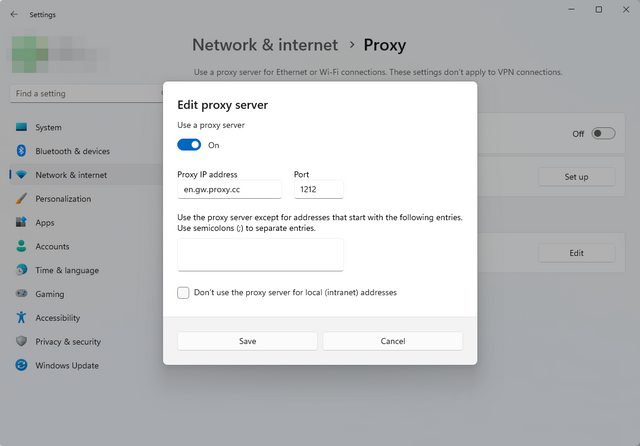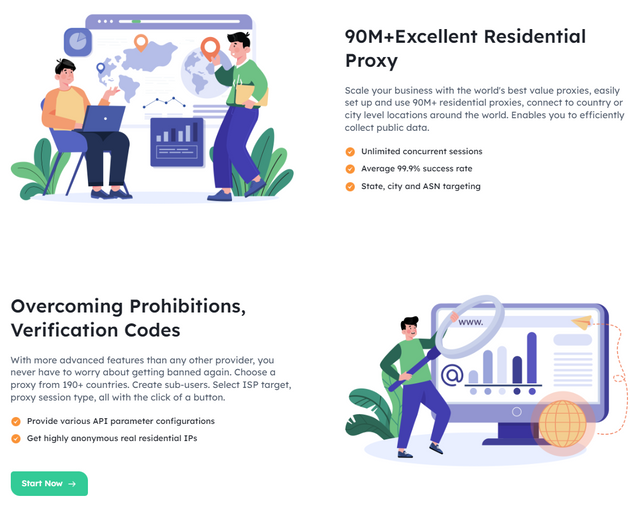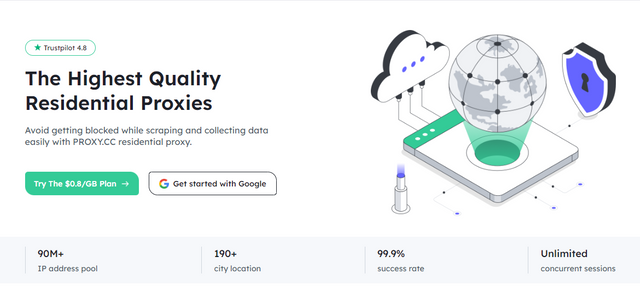Synopsis
Proxy Services have become a key tool in our daily work to protect network security and privacy, whether it's an employee accessing a website or a developer using a Web crawler to Scraping data. However, when using these Proxies, we often encounter some headaches, the most common of which is the 407 error.

When we access certain websites or online services through Proxy Services, the sudden 407 error prompt usually means that the Proxy Service needs you to authenticate. However, the request is rejected due to incorrect settings, wrong credentials, or failure to provide correct information.
The appearance of 407 error is not just an ordinary operation failure, it often triggers a series of troubles. Recurring 407 errors may prevent us from accessing important websites or online resources, directly affecting work progress and even hindering data collection or other network-dependent work. Not only do such errors disrupt daily operations, they may also prevent us from accessing the information we need at critical moments, which in turn drastically reduces work efficiency. Worse still, frequent 407 errors may hint at deeper problems with the Porfiles or Proxies configuration, which may worsen if not addressed in time.
Therefore, it becomes especially important to figure out the cause of 407 errors and configure the authentication information correctly when using Residential Proxies. As Residential Proxies have the characteristics of Rotating IP addresses and real residential networks, they are often used to bypass geographical restrictions and improve network security. However, if not properly configured, these advantages can instead cause trouble, leading to frequent 407 errors and severely impacting the user experience. In the next section, I will explain the causes of 407 errors in detail and discuss how to resolve and prevent these problems.
What is HTTP status code 407 error?
HTTP status code 407, is one of the more common but somewhat headache-inducing error codes that usually occurs when you are accessing a certain website or online resource through Proxy Services. What this error means is that the Proxy Service needs you to authenticate yourself first, that is, it wants you to provide a username and password to confirm your identity. However, if you don't provide this information, or the information is incorrect, the Proxy Service will return a 407 error, preventing you from continuing to access the target resource.

From a technical point of view, a 407 error is a signal from the Proxy Service when processing a request that tells the client, "You need to authenticate with me before you can proceed with access." This is somewhat similar to our common 401 error, which refers to the need for authentication when accessing the server directly, while the 407 error specifically addresses authentication when accessing through Proxy Services.
In practice, 407 errors usually occur when using a company network, a school network, or through third-party Proxies. In these scenarios, Proxy Services are used to manage and control access to external resources to ensure network security or to comply with company network usage policies.
When the Proxy Service asks for authentication, if the client (e.g. your browser or an application) does not provide the correct username and password, this can result in a 407 error. The next time you encounter this problem, think of the 407 error as a "login and password error" that occurs when accessing network resources through Proxy Services. Using PROXY.CC's Rotating Residential Proxies can help you solve this problem easily.
So how do you fix a 407 error?
- Inspection of Proxies
- Browser Settings: First, open your browser and go to Network or Proxy Settings to see if you have correctly entered your Proxy Service address, port, username and password. Many times, 407 errors are due to these information being filled out incorrectly. So double check to make sure everything is okay.

- Application Settings: If you are experiencing a 407 error with a particular application, such as a web crawler or email client, then go ahead and check the Proxies settings for that application. Make sure the Proxies information and login credentials are filled out correctly. Many programs have their own network settings menu, so just go in and take a look.
- Confirm that the username and password are correct
- Proxy Services usually ask you for a username and password, so if a 407 error occurs, first make sure that you have entered the information correctly. You can try entering them again or updating them to see if you made a mistake. If you're not sure about the username and password, you can contact the network administrator in your company or the Proxies service provider directly and ask them to give you the correct information.
- Check the validity of the Proxies account.
- There is also the case that the Proxy Service account or password has expired or someone has changed it, and that's when you'll see the 407 error. So, check if your Proxies account is still valid. If you find that the account is not valid, contact the administrator quickly to get the valid credentials again.
- Contacting the network administrator
- If you are experiencing a 407 error in your company or school network, it is best to get help from your network administrator. In this case, they are the ones who know the most about network settings and can help you check the Proxy Service configuration to see if something is wrong. They can also help you reset your account information or just provide you with the correct setup so you can get online.
- Disabling or bypassing Proxies
- Sometimes the Proxy Service itself may be the source of the problem. If you feel that you can access network resources just fine without going through Proxies, try turning off the proxy settings and connecting directly to the network. Of course, turning off the Proxies may prevent you from accessing some internal company resources, so consider whether you necessarily need to access something through a proxy before doing this step.
- Clear the browser cache or restart the device
- Sometimes, old settings in the browser cache can cause problems with authentication. In this case, clearing the browser cache or simply rebooting the device can often solve the problem. A reboot can refresh many system settings and sometimes make the error disappear without a trace.
How do you get to the root of the 407 error?
Although adjusting Proxies settings and entering authentication information correctly can temporarily alleviate 407 errors, it often does not completely resolve the problem. The limitations of traditional Proxies become apparent, especially in situations where frequent IP address changes are required.
This is where Rotating Residential Proxies come in handy. It solves these problems by providing Rotating IP addresses and IPs from real residential networks. Unlike Fixed IPs or Data Centre Proxies, Rotating Residential Proxies use IP addresses from real residential networks that look like the IPs of regular home users and are therefore harder to block. Furthermore, Rotating Residential Proxies can switch IPs automatically, which means that each request is sent through a different IP address, greatly reducing the risk of triggering a 407 error.
Another great advantage of Rotating Residential Proxies is that it reduces authentication failures. When Proxies IPs change frequently and come from a real residential network, the target server is more likely to pass authentication, which improves the success rate of network requests. For those who experience 407 errors on a regular basis, Rotating Residential Proxies not only solves the problem, but also significantly improves productivity.
How do Residential Proxies resolve 407 errors?
So, how exactly does the Rotating Residential Proxies resolve the 407 error? To understand this, we first need to understand that the core problem with the 407 error is an authentication failure, which is usually related to the Proxy Service's IP address. When you use traditional Proxy Services, the IP addresses are often fixed or come from a data centre, and these IPs are easily identified and blocked by the target server. Once these IPs are recognised as Proxies, the server will be suspicious of these requests, or even deny access outright, leading to authentication failures, which in turn triggers a 407 error.
Rotating Residential Proxies solve this problem by providing Rotating and real residential IP addresses. Rotating Residential Proxies use Proxies that are sourced from real residential networks around the globe that look like the addresses of regular home users.Rotating Residential Proxies provided by Proxies.CC not only reduces authentication failures, but also ensures that you have smooth access to those restricted resources around the world. Click to try Rotating Residential Proxies for free!
As a result, the target server is more inclined to perceive these requests as connections from real users rather than Proxy Services when processing them. This sense of authenticity greatly increases the success rate of authentication passing and reduces the likelihood of the server denying access.
What's more, the IP address of the Rotating Residential Proxies is Rotating, which means that the Proxies IP may be different every time you send a request. This automatic IP switching further reduces the frequency of 407 errors. Even if an IP address is recognised and blocked by the target server for some reason, the next request is immediately attempted using a completely new IP address, thus avoiding authentication failures due to repeated use of the same IP address. This Rotating feature gives you more flexibility in network access without having to worry about the whole task being interrupted if a certain IP is blocked.
In addition, Rotating Residential Proxies don't just excel at authentication, they also ensure that you have smooth access to those restricted resources across the globe. For Market Research, data collection, or even accessing geo-restricted websites, Rotating Residential Proxies provide you with a stable and reliable internet connection. With these real residential IPs, you can easily bypass geo-restrictions and gain the same access as regular users, avoiding authentication failures or blocked access due to IP issues.
Using you no longer need to worry about the hassle of 407 errors. Our service not only improves the success rate of network requests, but also provides you with more flexibility and security. Whether you are an enterprise user or an individual user, our Rotating Residential Proxies can help you successfully complete tasks in a variety of complex Porfiles. You can carry out all kinds of Web activities with confidence, from market research to Web Scraping to accessing restricted content, all of which can be handled with ease, without any further delays due to authentication failures.
All in all, Rotating Residential Proxies completely solves the problem of frequent 407 errors by Rotating Residential Proxies by switching real residential addresses Rotatingally, making your network requests smoother and more efficient.
How do you use Residential Proxies to resolve 407 errors?
To give you a better visualisation of the benefits of Rotating Residential Proxies, let's share a few real-life examples of how it has been effective in reducing 407 errors and increasing productivity.
We have a client that does market research and data capture. They need to capture a lot of data from various online resources every day, but they frequently encounter 407 errors when using traditional Proxy Services. Every time there is an authentication failure, data capture is interrupted, which wastes time and affects the work progress.
To get out of this dilemma, they tried our Rotating Residential Proxies. It turned out that because the Proxies IPs were Rotating and coming from real Residential Proxies network, the success rate of authentication was much higher and 407 errors almost no longer occurred. The data collection process became much smoother and the task was completed much faster. This not only made their work more efficient, but also gave them a better position in the market, enabling them to complete data collection faster and provide timely analysis reports.
There is another client, a freelancer, who mainly helps companies do online marketing and data analysis. He needs to access some geo-restricted websites frequently, but when using traditional Proxies, he was often denied access due to 407 errors, which greatly affected his work efficiency and even delayed the progress of the project. Later, he started to use our Rotating Residential Proxies and these problems were solved at once. He was able to easily bypass geographic restrictions and smoothly access various resources, authentication was no longer a problem, and work efficiency improved significantly.
These cases fully illustrate the effectiveness of Rotating Residential Proxies in reducing 407 errors and improving work efficiency. Whether you are a business user or an individual user, using our Rotating Residential Proxies will be of great help in your work.
Because it provides an address from a real residential network, it is easier to pass authentication. Firstly, configure the address and port of the Residential Proxies correctly in your browser or application, along with entering the correct username and password. If your Proxies support Rotating IP switching, make sure this is enabled so that each request uses the new IP, reducing the risk of being blocked by the server and thus reducing the occurrence of 407 errors.

By using these features of Residential Proxies, you can effectively avoid authentication failures and make your web requests smoother and less plagued by 407 errors.
Conclusion
Through this article, we have explored in detail the causes of 407 errors and various solutions, especially how to use Rotating Residential Proxies to get rid of these troubles for good. For a complete solution to 407 error problems, you can try the services of PROXY.CC for smooth and efficient internet access.

With the advantage of Rotating Residential Proxies to Rotatingally switch between IPs and real residential network IPs, they can effectively reduce the problem of failed authentication and make you smoother in network access. Whether you are a business user or an individual user, after mastering these tips, you will be able to cope with various network challenges at work more comfortably and maintain an efficient working pace.